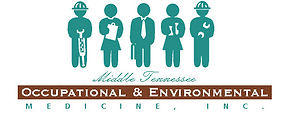
936 Murfreesboro Rd.
Lebanon, TN 37090
1227 Heil Quaker Blvd.
LaVergne, TN 37086
615-443-1744
615-641-3080
Middle Tennessee Occupational
&
Environmental Medicine, Inc.




Occupational Medicine Network, Inc. (OMNI)
Occupational Medicine Network, Inc. provides occupational medicine consulting services to providers and entities desiring to expand and maximize occupational medicine services. Call 1-866-213-5148 for more information.

DOT Provider Certification Training
Login to omnitotalsolutions.com for DOT provider certification training and to earn significant CME credits.

Onsite Services
Whether managing independent occupational medical units or partnering with contract entities, MTOEM has proven experience in providing comprehensive occupational medicine services.

Mobile Unit
A mobile unit is available for onsite services such as random testing, drug screening, vision testing, hearing testing, etc.

Rehab & Physical Therapy
Prevention is goal number one. If an injury occurs, however, and requires rehab, MTOEM has facilities onsite to help expedite the healing process.

Physician Consulting
Board Certified Occupational Medicine Physician licensed throughout the country to perform asbestos exams, independent medical exams, legal review and depositions, etc.
Non-surgical Orthopaedic consults available with minimal wait time and in-house casting.
Our Practice
Middle Tennessee Occupational & Environmental Medicine, Inc. (MTOEM) has been providing
services to businesses and their employees throughout the area for over 25 years. The Medical Director is a Board Certified, Fellow in Occupational and Environmental Medicine.
MTOEM specializes in providing comprehensive services to business and industry to satisfy employee related healthcare needs.
We help employers promote optimal health and wellness in the workplace. MTOEM works closely with employers to develop and implement preventive and proactive stategies to minimize injury and illness, lost work time, and claim costs.
THE PRACTICE
Infectious Diseases Impact Millions: How Employers can Protect Workers
In the wake of the Ebola cases contracted outside of the “hot zone” of Western Africa, it’s important for businesses to take a step back and assess their own respective infection/exposure control programs. Rest assured, the vast majority of people will never come into contact with this deadly disease, but the concern engendered by the news is a good reminder that there are many other common infectious diseases prevalent throughout our country and the world. Businesses need to know how to keep their workers safe and healthy.
More common diseases such as influenza, pertussis, tuberculosis, Methicillin-resistantStaphylococcus aureus (MRSA), rhinovirus, and norovirus–to name a few–affect millions of people every year and can spread throughout an organization in a relatively short time. In a matter of hours, one sick worker could potentially pass an illness to dozens or even hundreds of people. How many times have you gone to work feeling “under the weather” and ended up home in bed the next day? Now imagine how many people you came into contact with, how many people touched the same doorknobs or used the same bathrooms. That’s when you realize how easy it can be to spread an infectious disease.
It’s important to know how infectious diseases are transmitted. Within the workplace, the primary routes of infectious diseases are contact (direct and indirect), droplet, and airborne. Direct contact involves direct skin-to-skin contact, whereas indirect transmission occurs when infectious agents are transferred via physical contact with contaminated items and surfaces. Droplet transmission involves infectious agents that are released when a person coughs, sneezes, or talks, and come into direct contact with the mucosal surfaces (eyes, nose, or mouth) of another susceptible individual. Airborne transmission occurs when very small particles or droplet nuclei that contain the infectious agents are inhaled.
How can businesses best protect their workers from infection, and from infecting others?
One of the most pivotal processes is to maintain proper infection and control practices. Every workplace should uphold the Occupational Safety and Health Administration’s (OSHA) general duty clause and “provide all workers a workplace free from recognized hazards that are causing or likely to cause death or serious physical harm to their employees.” Businesses should make sure employees know:
§ Proper hand hygiene – handwashing with soap and water and the use of alcohol-based hand sanitizers
§ Proper respiratory hygiene/cough etiquette – cover mouth/nose when coughing or sneezing and use and dispose of tissues
§ Wearing of proper Personal Protective Equipment (PPE) when needed – examples of PPE include gloves, gowns, face masks, respirators, goggles and face shields
In addition to these steps, businesses need to reinforce the importance of staying home when workers are sick to further prevent spreading the infection. Companies that don’t offer paid time off for illness should consider it when aiming to keep workers safe and healthy on the job. Helping workers understand there won’t be punishment for taking a sick day is vital in the fight against infectious diseases. When workers come to work sick, factors such as close quarters, insufficient engineering controls, poor personal hygiene habits, and lack of management oversight can all lead to the spread of further infections. Companies have the ability to protect their employees through education, allowance for sick days, and vaccination programs. Helping employees prevent the spread of illness with vaccines or incentive programs can have a long-term reward for your organization.
Finally, workplaces need to be prepared. The best way to prevent and control the spread of infectious diseases in the workplace and healthcare settings is by maintaining awareness among the entire worker population. It could mean the difference between one person getting sick and having an infectious disease affect a large population. To better be prepared for a potential infectious disease outbreak, businesses should:
§ Begin planning now
§ Be vigilant
§ Be proactive
It’s essential for businesses to understand what needs to be done before, during, and after an outbreak occurs to minimize the further spread of the disease. With an effective infection control plan in place, including steps such as fundamental principles, education and training, surveillance, standard precautions and elements from OSHA’s Bloodborne Pathogen Standard, businesses can be assured that their employees are better guarded and they have greatly reduced the possibility of further infections.
Posted by Langdon Dement in Occupational Health